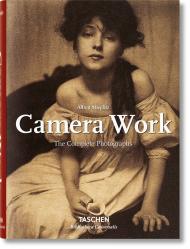Pioneers in photography as an art form. Highlights from Stieglitz's legendary photo journal (1903–1917)
Photographer, writer, publisher, and curator Alfred Stieglitz (1864–1946) was a visionary far ahead of his time. Around the turn of the 20th century, he founded the Photo-Secession, a progressive movement concerned with advancing the creative possibilities of photography, and by 1903 began publishing Camera Work, an avant-garde magazine devoted to voicing the ideas, both in images and words, of the Photo-Secession. Camera Work was the first photo journal whose focus was visual, rather than technical, and its illustrations were of the highest quality hand-pulled photogravure printed on Japanese tissue. This book brings together all photographs from the journal’s 50 issues.
About the series:
Bibliotheca Universalis — Compact cultural companions celebrating the eclectic TASCHEN universe at an unbeatable, democratic price!
Since we started our work as cultural archaeologists in 1980, TASCHEN has become synonymous with accessible, open-minded publishing. Bibliotheca Universalis brings together more than 100 of our all-time favourite titles in a neat new format so you can curate your own affordable library of art, anthropology, and aphrodisia.
Bookworm’s delight — never bore, always excite!
-------------
О книге alfred Stieglitz. Camera work
Alfred Stieglitz. Camera work рассказывает о знаменитом фотографе, Альфреде Стиглице. О его вкладе в преображение фотографии к виду искусства и легендарных снимков в журнале Camera work (1903-1917).
Фотограф, писатель, издатель и куратор известного журнала, Альфред Стиглиц (1864-1946) видел намного дальше своего времени. Примерно, на рубеже 20-го века он основал Photo-Secession – прогрессивное движение, связанное с повышением творческих возможностей в фотографии. И к 1903 году начал принимать участие в издательстве CameraWork – авангардного журнала, посвященного новым идеям в писательстве и фотографии.
Alfred Stieglitz. Camera work расскажет, как журнал Camera Work стал первым фотожурналом, который фокусировался на визуализации, а его иллюстрации – были высококачественными гравюрами, выполненными вручную на японской ткани. В этой книге собраны все фотографии из 50 номеров журнала.

